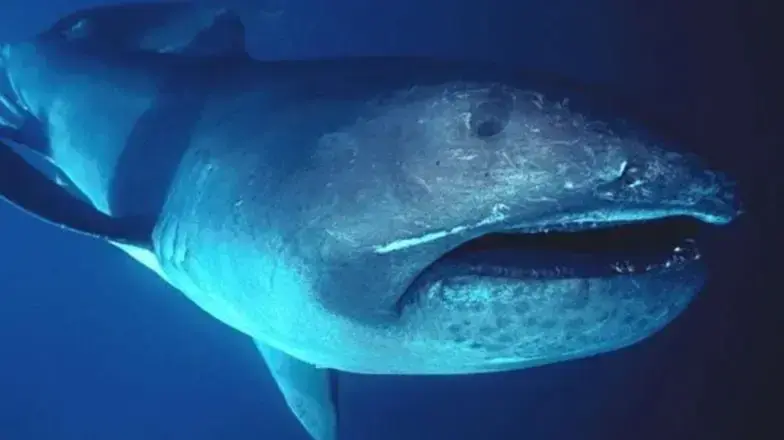Documentation of two bigmouth sharks (Val Costescu, , David Stabile, and Andrew Chang)
A rare video shows two largemouth sharks swimming off the coast of San Diego, being the only documentation of the scientists that reveals information about the social life of the sharks of this species - an extremely rare species of shark that lives in deep water, which was discovered only in 1976.
The video released this month was taken by fishermen in early September 2022, and is said to show the sea creatures in a courtship ceremony - and is one of a very small handful of sightings of them.
In the 50 years since the species was discovered, only 273 sightings have been collected, most of them of largemouth sharks caught in fishing gear.
Only five sharks have been observed swimming freely in the wild, and no two have ever been seen swimming together.
Now, new research analyzing the footage suggests that both sharks were engaged in courtship or pre-mating behavior.
"The curiosity of these fishermen benefited the field as a whole," study author Zachary Skelton, a graduate student at the University of California, San Diego, told Live Science.
"The 10 minutes the fishermen had with the sharks contains the only knowledge we have about the social behavior of these sharks."
More on the subject:
Thanks to an underwater robot: a special shark was recorded for the first time in the depths of the Gulf of Eilat
"Our experiment proves that enormous creatures are hidden in the depths of the ocean"
More in Walla!
The leading health fund presents: the services that will make your life easier
in collaboration with Kalit
A large mouth shark usually reaches a length of 5.5 meters and its weight can reach 1,215 kilograms.
The shark digs its food out of the water with its huge mouth wide open - and it feeds on plankton and jellyfish.
This species of shark does not resemble any other shark known to science, and therefore received its own classification in the large mouth shark family.
"It's pretty rare to see one of them, let alone two swimming on the surface during the day," Christopher G. Lowe, director of the shark lab at California State University Long Beach, who was not involved in the study, told Live Science.
To better understand the sharks' behavior, Skelton and his colleagues analyzed the footage in light of everything they could find in the literature on the social behaviors of other filter-feeding sharks, such as the giant shark (Cetorhinus maximus) and the whale shark (Rhincodon typus).
"Because the encounter was so short, we had to rely heavily on research and other species to try and understand why the sharks were at the surface, why they were together and why they were in that particular place," Skelton said.
This is what is known about this mysterious shark
The visible male genitalia suggested that the smaller of the two sharks was male.
Although the team was unable to confirm the gender of the second shark, they determined that it was likely a female, based on the lack of a visible genitalia and a series of scars on its back similar to the mating scars found on female sharks of other species.
Given that the male was closely following the presumed female shark and that none of the sharks were seen trying to eat, the researchers concluded that the footage likely reflected some sort of courtship ritual.
The results were published March 13 in the journal Environmental Biology of Fishes.
"This anecdotal observation has all the hallmarks of premating behavior," Carl Meyer, an associate researcher in the Shark Research Laboratory at the Hawaii Institute of Marine Biology, who was not involved in the study, told Live Scienc.
"We still know relatively little about the biology and ecology of largemouth sharks, so this observation is an interesting addition to our understanding of this species."
Neil Hammerschlag, Director of the Shark Research and Conservation Program at the University of Miami, had a similar impression: "The social behavior of these sharks is still like a closed box for scientists - and observations like these are exciting and generate a set of questions and theories that can be tested in future studies."
tourism
Tags
sharks
shark





